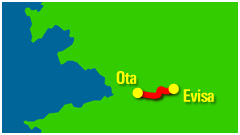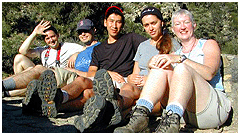 The walk from Ota to Evisa is short but involves some steep climbs.
The walk from Ota to Evisa is short but involves some steep climbs.
 9am in Ota. Due to its position in the valley, the village receives no direct sun until late morning.
9am in Ota. Due to its position in the valley, the village receives no direct sun until late morning.
 It's hard to see here, but that's our group! Irina, Ed, Will and Jonica stand together atop the Ponte Vecchio bridge.
It's hard to see here, but that's our group! Irina, Ed, Will and Jonica stand together atop the Ponte Vecchio bridge.
 A little closer this time. That's me, Will, Ed, Irina, and Jonica, on the bridge.
A little closer this time. That's me, Will, Ed, Irina, and Jonica, on the bridge.
 Vertical pinnacles of rock rise up around us on the path through the Gorge de Speloncata.
Vertical pinnacles of rock rise up around us on the path through the Gorge de Speloncata.
 This is the view from our hotel balcony in Evisa. Up here in the hills the leaves are turning but the pool chairs are still out.
This is the view from our hotel balcony in Evisa. Up here in the hills the leaves are turning but the pool chairs are still out.
 Jonica and Irina (left) relax in the sun as Ed (right) steels himself for a quick dip in the chilly waters of the Hôtel L'Aïtone's pool.
Jonica and Irina (left) relax in the sun as Ed (right) steels himself for a quick dip in the chilly waters of the Hôtel L'Aïtone's pool.
Everyone has their trail legs now and is raring to go. We leave Ota by a shady, boulder-strewn track that leads gently downhill to a calm, clear river. Spanning this brook is the first of two ancient stone bridges we are due to pass today.
Between the 13th and 18th centuries, Corsica was largely controlled by the Italian city-state of Genoa, and it was during this period that many of the island's architectural gems were constructed. The stone bridges of Ponte Vecchio and Pont de Zaglia, further up the trail, are two prime examples. Both single-arch bridges are exquisitely delicate in form, and the fact that they remain standing today is a testament to the strength and integrity of Italian Renaissance design.
The serene setting of Ponte Vecchio makes for a picture-postcard view. We set off again, stopping briefly at a wholly unexpected football ground — it's in the middle of nowhere on the canyon floor but I guess the local kids have to play somewhere — to kick a half-inflated soccer ball around as Jonica and Irina play the cheerleader roles from the sidelines. Three goals later we move on.
After Pont de Zaglia the route zigzags steeply upwards out of the gorge. The going is tough but the views get better the higher we climb. Then suddenly we've made it. The path dumps us onto the main road, right next to a signpost welcoming us to Evisa.
It's a long village, strung out on the side of a hill. We stroll through what appears to be a ghost town (once again, it's siesta time), kicking our way through piles of fallen leaves and chestnuts.
Jacko, the Hôtel L'Aïtone's parrot “watchdog”, caws at us as we amble in. We book into three spacious rooms with balconies, which overlook a seemingly inviting outdoor pool. To Ed's shock and dismay, it turns out to be full of ice cold water. Cue laughter from the rest of us sitting in the comfort of our warm poolside deckchairs (listen).
Tomorrow is the final day of our walk.